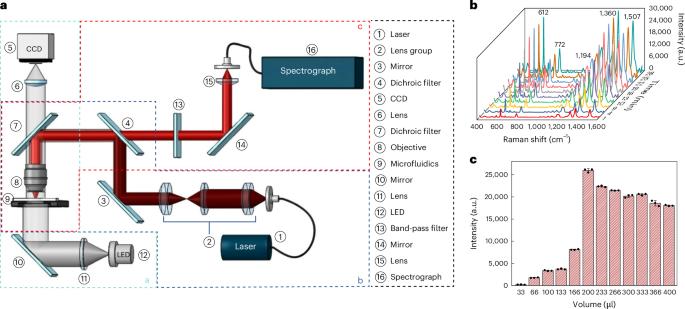Capturing, enriching and detecting nanoplastics in water based on optical manipulation, surface-enhanced Raman scattering and microfluidics
IF 24.1
引用次数: 0
Abstract
Aqueous concentrations of nanoplastics are critical for their risk assessment. Here we developed an optical manipulation and surface-enhanced Raman scattering set-up to capture, enrich and detect nanoplastics in aquatic environments. A small-sized (20 µm) gold nanoparticle stack was used to design a gold nanoparticle stack/polylactic acid optical tweezer, and individual nanoplastics were precisely manipulated. A large-sized (80 µm) gold nanoparticle stack enabled massive enrichment of nanoplastics, and high enrichment recoveries (for example, 89.3–94.3% for polystyrene) and low limits of detection (for example, 150 ng l−1 for polystyrene) of nanoplastics were achieved. Moreover, interference from natural organic matter was eliminated by adding a cleaning step before detection. The nanoplastics in natural waters (required volume, ≤7.2 ml) were thus successfully enriched and analysed, with determined concentrations of polystyrene nanoplastics of 6.5–8.5, 1.4–1.8 and 0.7–1.0 μg l−1 for water samples from a river, a mariculture farm and a beach, respectively. This newly developed optical manipulation–surface-enhanced Raman scattering approach is able to simultaneously enrich and detect nanoplastics in natural waters. The use of an optical manipulation set-up combined with the high sensitivity of surface-enhanced Raman spectroscopy allows the simultaneous enrichment and detection of nanoplastics. This technique has great potential for the analysis of trace amounts of nanoplastics in natural waters.

基于光学操作、表面增强拉曼散射和微流体的水中纳米塑料捕获、富集和检测
纳米塑料的水浓度对其风险评估至关重要。在这里,我们开发了一种光学操作和表面增强拉曼散射装置来捕获、富集和检测水生环境中的纳米塑料。采用小尺寸(20µm)金纳米粒子堆设计金纳米粒子堆/聚乳酸光镊,并对单个纳米塑料进行精确操作。一个大尺寸(80µm)的金纳米颗粒堆栈使纳米塑料大量富集,并实现了纳米塑料的高富集回收率(例如聚苯乙烯为89.3-94.3%)和低检测限(例如聚苯乙烯为150 ng l−1)。此外,通过在检测前增加一个清洗步骤,消除了天然有机物的干扰。因此,我们成功地富集和分析了天然水体(所需体积≤7.2 ml)中的纳米塑料,在河流、海水养殖场和海滩的水样中,聚苯乙烯纳米塑料的浓度分别为6.5-8.5、1.4-1.8和0.7-1.0 μg l - 1。这种新开发的光学操作-表面增强拉曼散射方法能够同时富集和检测天然水中的纳米塑料。利用光学操作装置结合表面增强拉曼光谱的高灵敏度,可以同时富集和检测纳米塑料。该技术在分析天然水体中微量纳米塑料方面具有很大的潜力。
本文章由计算机程序翻译,如有差异,请以英文原文为准。
求助全文
约1分钟内获得全文
求助全文

 求助内容:
求助内容: 应助结果提醒方式:
应助结果提醒方式:


